Your Environmental Road Trip
Air Date: Week of September 26, 2008
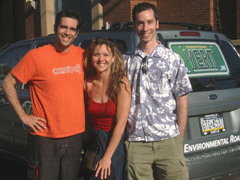
Ben Evan, Julie Evan, and Mark Dixon pose with "Rachel" the Ford Hybrid, named for Rachel Carson, they drove across the country.
Three friends drove to every state in the country to document the quirky things people are doing for the environment. Two of the trio, Mark Dixon and Julie Evans, talk with host Bruce Gellerman about their adventures.
Transcript
GELLERMAN: The great American road trip is a rite of passage for a lot of young people. But it was more than the open road that Julie and Ben Evans and their friend Mark Dixon were driving for. They hit the highways and byways of America in search of strange and quirky stories about the environment and video’d the people and places they encountered.
They called their year-long, 50 state adventure YERT or Your Environmental Road Trip. Two out of three YERTers join me. In Louisville, Kentucky is Julie Evans. Hi, Julie.
EVANS: Hi
GELLERMAN: And in the studio is Mark Dixon. He’s the third in the trio. Hi Mark
DIXON: Hi there.
GELLERMAN: Well, you know, when I was watching your videos, I was thinking this is like Hunter Thomson meets Rachel Carson.
[LAUGHING]
GELLERMAN: Here you’re preaching the gospel of the environment by driving across the country, going to all these bizarre and weird places, but you’re driving nonetheless. It doesn’t sound eco friendly to me.

Ben Evans, Julie Evans, and Mark Dixon pose with "Rachel" the Ford Hybrid, named for Rachel Carson, they drove across the country.(Photo: Sean MacInnes)
DIXON: Yeah, it’s the first oxymoron that we hit upon. Actually, we looked at doing a bicycle road trip. It turns out that I have a weird knee that doesn’t like to bike. The car we chose was about as small as we could get and still hold all of our equipment.
GELLERMAN: It was a hybrid.
EVANS: Yeah, it was a Ford hybrid. And we thought maybe it’s another way to get more people onboard who don’t even know what a hybrid is.
GELLERMAN: Well, what were the rules of the road.
DIXON: The first was that we had to keep all of our garbage with us. We’re trying to make no more than one shoebox of garbage per month across all three of us.
GELLERMAN: You were able to do that?
DIXON: Yeah, essentially we were.
[LAUGHING]
EVANS: We crammed it.
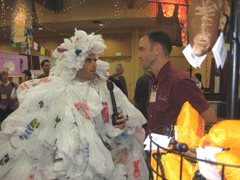
Ben Evans as the "Bag Monster" conducting an interview. (Photo: Julie Evans)
DIXON: Yeah, our feet were up by our heads. We actually started shipping home some of our less vital equipment and other things, other supplies, to make room for the garbage. You know, it was either garbage, or maybe your underwear.
EVANS: We really tried to plan ahead and have ways to kind of combat the garbage. And we talked to our waiters right when we sat down like “We’re doing an experiment. Please no straws, no napkins, no nothing.” And they mostly were really interested, so that was a huge help.
GELLERMAN: What are the other rules?
DIXON: Well, we also said we can’t turn on any incandescent light bulbs.
GELLERMAN: So were you in the dark quite a bit?
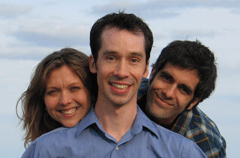
Julie Evans, Mark Dixon, and Ben Evans (Photo: Gregg Dixon)
DIXON: Yes, we were. And we used little LED headlamps. It made our hosts guilty a lot of the time. If they didn’t have a – if they didn’t have the right bulbs in their home, they would take one look at us sitting in the dark with our headlamps and feel so guilty that some of them would run out and buy compact fluorescents on the spot.
EVANS: We weren’t doing it to try to guilt anyone. We were just doing it for our own experiment. But it did sometimes turn out that way.
GELLERMAN: Where did the ideas for the stories come form? Did you just roll into town and say what’s strange, unusual weird about the environmental movement?
DIXON and EVANS: Sometimes.
[LAUGHING]
DIXON: Yeah, sometimes we would do just that.
EVANS: It’s a big country though, man. It is really huge. And there is so much going on.
GELLERMAN: You went to a town in Idaho, Elk Bend, I think it’s called. You met some very strange characters, living in some very strange circumstances.
DUG OUT DICK: I built that big rock house, down there.
EVANS: Yeah, that’s Dug Out Dick. He was a miner. He’s been living in a cave for about sixty years.
DUG OUT DICK: I built a house up here. They have to come up here to see me.
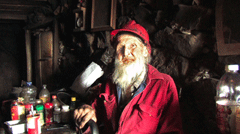
Dug Out Dick has been living in a cave in Elk Bend, Idaho for 60 years. (Photo: Ben Evans)
EVANS: He was looking for – looking for ore, didn’t really find it, but discovered that it was warmer in the cave than it was outside in the winter in Idaho. And so he actually furnished them. He went to dumps and he got wood stoves and he got mattresses and he made like - I don’t know – eleven or twelve little places where people could actually stay. And you could stay there for a dollar a night.
BRUCE: Look at me; I live in a cave. I’ve got everything you’ve got. I’ve got a comfortable chair. I’ve got a warm stove. I can cook, I can sleep, I can read.
EVANS: That’s Bruce. He’s lived there for several years and he pays his years in advance. I think its $300.
BRUCE: Progress, the way people look at it is all these great technological things, you know. But it’s really hurting the planet. What we really need to do is regress. Maybe grow gardens more than we do. Maybe live in a cave, you know.
GELLERMAN: Boy, it makes me want to head for the hills.
DIXON: It was some good living up there.
EVANS: Yeah, he loves it. He absolutely loves it. To him – you know – he still has a car. Bruce still has a car, and he goes to work and has a regular job.
GELLERMAN: Well, speaking of cars, let’s go to Salt Lake City Utah where you found national parking day.
EVANS: That happens all over the country I think. We just happened to hit it on the right weekend in Salt Lake City, I think.
[ROCK MUSIC]
WOMAN: And so it’s just a way to kinda raise awareness of the importance of parks by building one park at a time, one stall at a time, one dime at a time, or quarters now.
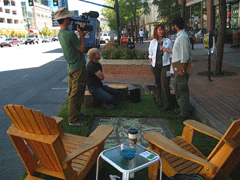
Mark Dixon films Ben Evans interviewing a park goer on parking day. (Photo: Julie Evans)
GELLERMAN: Well this is where people put some money into a meter and then that space becomes theirs and they don’t use it to park their cars. They can do whatever they want with that space.
DIXON: Oh yeah, they’ll put down some grass and maybe a park bench and a tree, and we played football in one of them.
EVANS: Croquet
DIXON: Yup, croquet too. It was a good time.
[ROCK MUSIC]
DIXON, EVANS: Utah, where all the streets are paved with grass.
[MUSIC ENDS]
GELLERMAN: Let’s listen to another clip. You went off to Iowa, Des Moines, I guess it was – for the corn challenge?
[MUSIC]
MAN: We call this the all corn, many corn, no corn challenge.
EVANS: oh right.
DIXON: Yes, our very own corn challenge.
[LAUGHING]
EVANS: That was Mark’s favorite week of digestion.
GELLERMAN: I guess you had to eat only corn products basically.
DIXON: Well just corn off the cob.
I really can actually understand how corn fed beef feels – crappy. I – I feel like crap.
EVANS: Yeah, he could only eat corn. Ben could eat corn, anything that had corn in it, anything at all that had corn in it.
GELLERMAN: That’s right. Your husband, Ben.
[MUSIC, CRUNCHING OF CHIPS BEING EATEN]
DIXON: Potato chips
BEN: hmmm.
DIXON: Relish
BEN: Yup, I’m really slumming it here dude. I don’t know how I’m going to make it through five whole days of eating 90% of what’s in the grocery store.
GELLERMAN: And you ….
EVANS: … could eat nothing that had corn.
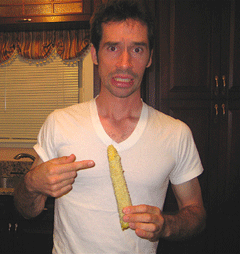
Mark Dixon ate only corn on the cob for 5 days as his part of the corn challenge. (Photo: Julie Evans)
[MUSIC]
EVANS: Corn challenge breakfast. Oops. Who would think that there’s corn in your yogurt. Corn syrup solids. Corn starch modified.
[MUSIC FADES]
EVANS: That’s when we discovered that most things have corn in them. Then suddenly I had to really, really read my labels. And that’s why I ended up eating mostly fresh fruit.
GELLERMAN: Why did you call it Your Environmental Road Trip, not, you know, Our Environmental Road Trip?
DIXON: We really wanted to make it a participatory event. We didn’t want it to be just about us. We wanted it to be about everybody, and for everybody to embrace both the root and the people we met and take it upon themselves to maybe make a different in their life.
EVANS: And we still want it to be inclusive, very much.
GELLERMAN: Well Julie, thank you very much.
EVANS: Thank you so much. It was a pleasure and honor.
GELLERMAN: And Mark, you too.
DIXON: Thank you. Had a great time.
GELLERMAN: Mark Dixon, and Julie Evans recently finished their, or should we say Your Environmental Road Trip, YERT. Julie’s husband Ben was home with their new baby. She was born during the trip. For a link to view YERT’s videos, go to our website loe.org
Links
Living on Earth wants to hear from you!
Living on Earth
62 Calef Highway, Suite 212
Lee, NH 03861
Telephone: 617-287-4121
E-mail: comments@loe.org
Newsletter [Click here]
Donate to Living on Earth!
Living on Earth is an independent media program and relies entirely on contributions from listeners and institutions supporting public service. Please donate now to preserve an independent environmental voice.
NewsletterLiving on Earth offers a weekly delivery of the show's rundown to your mailbox. Sign up for our newsletter today!
 Sailors For The Sea: Be the change you want to sea.
Sailors For The Sea: Be the change you want to sea.
 The Grantham Foundation for the Protection of the Environment: Committed to protecting and improving the health of the global environment.
The Grantham Foundation for the Protection of the Environment: Committed to protecting and improving the health of the global environment.
 Contribute to Living on Earth and receive, as our gift to you, an archival print of one of Mark Seth Lender's extraordinary wildlife photographs. Follow the link to see Mark's current collection of photographs.
Contribute to Living on Earth and receive, as our gift to you, an archival print of one of Mark Seth Lender's extraordinary wildlife photographs. Follow the link to see Mark's current collection of photographs.
 Buy a signed copy of Mark Seth Lender's book Smeagull the Seagull & support Living on Earth
Buy a signed copy of Mark Seth Lender's book Smeagull the Seagull & support Living on Earth

